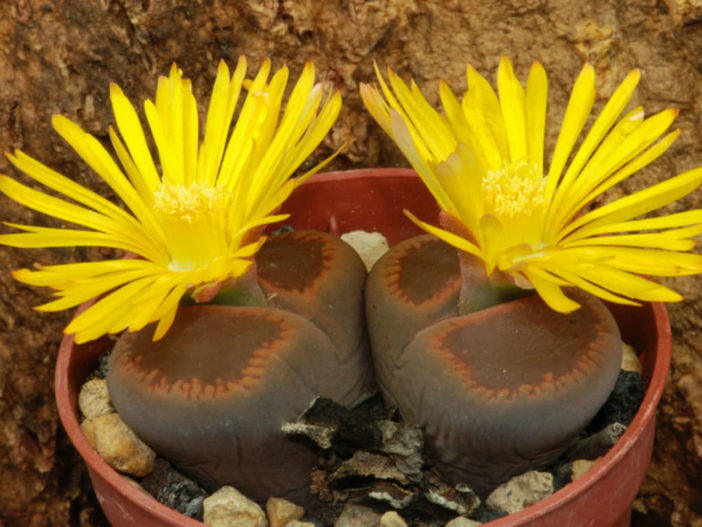Scientific Name
Lithops aucampiae L. Bolus
Common Name(s)
Living Stones, Stone Plant
Synonym(s)
Lithops aucampiae subsp. aucampiae, Lithops loganiae, Lithops loganii
Scientific Classification
Family: Aizoaceae
Subfamily: Ruschioideae
Tribe: Ruschieae
Genus: Lithops
Description
Lithops aucampiae is a small succulent with brown-red bodies composed of two fleshy leaves with darker markings at the tips and divided by a shallow fissure from which the new leaves and the yellow flower appear. It may form small clusters of up to 12 (usually 2 to 5) bodies with age. The bodies are up to 2.2 inches (5.5 cm) tall and up to 1.6 inches (4 cm) across.
The flowers are daisy-like, bright yellow, up to 2 inches (5 cm) in diameter, and appear in fall.
Origin
Lithops aucampiae is native to South Africa. It occurs in the northeastern part of the country, the former Province of the Transvaal, growing in ironstone areas with sandstone, chert, and quartzite.

Hardiness
USDA hardiness zones 10a to 11b: from 30 °F (−1.1 °C) to 50 °F (+10 °C).
How to Grow and Care
These plants develop a new set of leaves every year, with new leaves emerging in the fall and growing through the winter and into the summer. Lithops will go dormant in late summer, and water should be severely restricted to prevent bursting leaves. The flowers appear near the end of summer or fall, first showing up as a small bud forcing its way between the leaves, and growth will begin again. It's safe to water during this period. The leaves will still grow into the winter, but you should stop watering, even as the older leaves shrivel and encase the new growth. In the spring, it's safe to begin lightly watering again as the plant starts to grow again, heading toward its summer dormancy period and the emergence of new leaves in the fall.
Lithops are very slow-growing, small plants, making them ideal as houseplants (once you get the hang of their watering schedule). Older plants form attractive clumps of "pebbles" in their pots, which are highly prized. In general, plants should only be repotted if there are cultural problems (soggy soil) or the plant has outgrown its dish container, which will only happen every several years.
Learn more at How to Grow and Care for Lithops.
Links
- Back to genus Lithops
- Succupedia: Browse succulents by Scientific Name, Common Name, Genus, Family, USDA Hardiness Zone, Origin, or cacti by Genus
Photo Gallery
Click on a photo to see a larger version.



